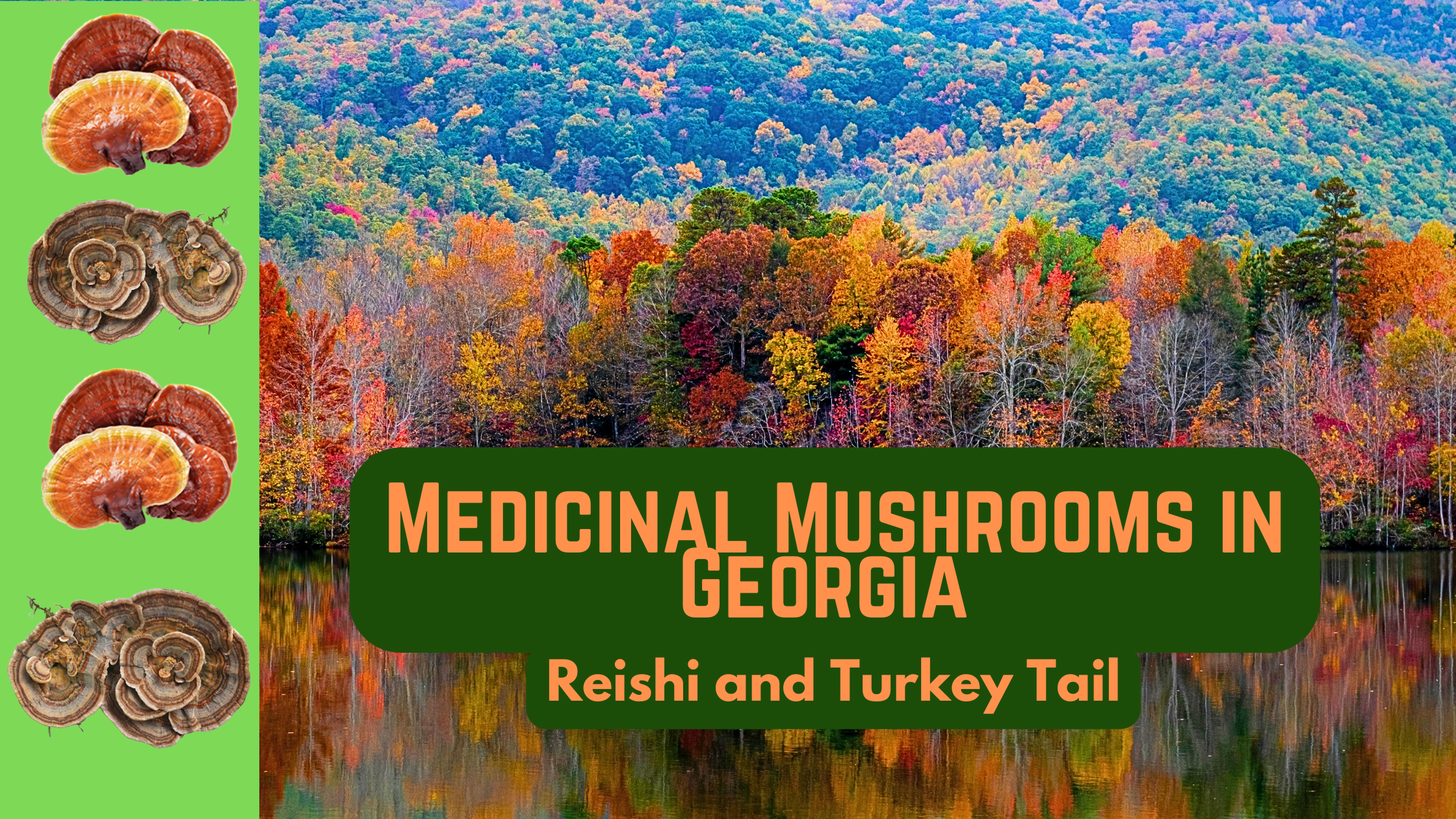Table of Contents
Georgia’s lush forests and diverse ecosystems offer a treasure trove of medicinal mushrooms, waiting to be discovered by enthusiastic foragers. Foraging for mushrooms is not just a delightful adventure but also an opportunity to tap into nature’s pharmacy. In this article, we will explore two powerful medicinal mushrooms found in Georgia: Reishi (Ganoderma curtisii) and Turkey Tail (Trametes versicolor). These mushrooms have been celebrated for centuries for their health benefits, and today, we’ll delve into their properties, where to find them, and how to use them.

Reishi (Ganoderma curtisii)
Health Benefits
Reishi mushrooms, also known as “the mushroom of immortality,” have a long history in traditional medicine, particularly in Asia. Modern research supports many of the claims about Reishi’s health benefits. Studies have shown that Reishi can help boost the immune system, reduce stress and anxiety, and improve sleep quality. It also has anti-inflammatory and antioxidant properties, which contribute to overall well-being (Jin et al., 2016).
Identifying Reishi
Reishi mushrooms have a distinctive appearance, making them relatively easy to identify. They grow on hardwood trees, particularly oaks, and are typically found at the base of the tree or on stumps. Reishi has a shiny, varnished-looking cap that can range in color from reddish-brown to dark brown. The underside of the cap is white to cream-colored and has fine pores instead of gills.

Where to Find Reishi in Georgia
Reishi mushrooms thrive in the warm, humid climate of Georgia. You can find them in hardwood forests, particularly in areas with decaying wood and plenty of moisture. Look for Reishi from late spring to early fall. Some of the best places to forage for Reishi in Georgia include the Chattahoochee National Forest and the Okefenokee Swamp.

Harvesting and Using Reishi
When harvesting Reishi, use a sharp knife to cut the mushroom at the base or gently pull it out, holding from the base of the mushroom. Once harvested, Reishi can be dried and used to make teas, tinctures, or even powdered for capsules. The bitter taste of Reishi tea can be balanced with honey or ginger.

Turkey Tail (Trametes versicolor)
Health Benefits
Turkey Tail mushrooms are another powerhouse of medicinal benefits. They are particularly renowned for their immune-boosting properties. T.t also helps fight against illnesses, disease, and aids with digestion. Research has shown that Turkey Tail contains polysaccharide-K (PSK) and polysaccharide peptide (PSP), compounds that have been used in cancer therapy to support the immune system (Ooi & Liu, 2000). Turkey Tail is also rich in antioxidants, which help combat oxidative stress and support overall health.
Identifying Turkey Tail
Turkey Tail mushrooms are small, fan-shaped fungi that grow in layered clusters on dead or decaying wood. They have a distinctive pattern of concentric, colorful rings that resemble a turkey’s tail, hence the name. The colors can range from browns and grays to vibrant blues and greens. The underside of Turkey Tail is white or light-colored and covered with tiny pores.

Where to Find Turkey Tail in Georgia
Turkey Tail mushrooms are common in Georgia’s forests and can be found year-round. They prefer hardwood trees and are often found on fallen logs, stumps, and dead branches. Good places to search for Turkey Tail include the Piedmont region and the Appalachian foothills.

Harvesting and Using Turkey Tail
To harvest Turkey Tail, gently cut the mushroom close to the wood surface with a knife. Like Reishi, you can also gently pull the mushroom from it’s base. Turkey Tail can be dried and brewed into a tea, which has a mild, earthy flavor. It can also be powdered and added to smoothies or soups for a nutritional boost.
Practical Tips for Foraging
- Start Small: If you’re new to foraging, start with small, manageable areas and gradually expand as you become more confident in identifying mushrooms.
- Learn from Experts: Join local foraging groups or take a guided hike with an experienced mycologist to learn about mushroom identification and safety.
- Use a Field Guide: Invest in a good field guide specific to your region to help with mushroom identification. Feel free to reach out to us for recommendations.
- Respect Nature: Always forage responsibly. Take only what you need and leave some mushrooms behind to ensure they can continue to grow and support the ecosystem.
- Safety First: Never consume a mushroom unless you are 100% sure of its identification. Some mushrooms can be toxic, and it’s essential to forage with caution.
Conclusion:
Foraging for medicinal mushrooms like Reishi and Turkey Tail in Georgia’s forests is a rewarding experience that combines the joy of nature exploration with the benefits of natural health remedies. These mushrooms offer incredible health benefits, from boosting the immune system to reducing stress and inflammation. By learning to identify and harvest these mushrooms responsibly, you can tap into the rich natural resources of Georgia and enhance your well-being.
Stay tuned for Part 2, where we’ll explore more medicinal mushrooms found in Georgia and provide additional foraging tips.
Whether you’re a seasoned hiker or a novice forager, the journey to discover these medicinal treasures is a path worth taking. Lace up your boots, grab your basket, and let’s explore the great outdoors together!
References:
- Jin, X., Ruiz Beguerie, J., Sze, D. M. Y., & Chan, G. C. F. (2016). Ganoderma lucidum (Reishi mushroom) for cancer treatment. Research Progress on Ganoderma Lucidum: A Review.
- Ooi, V. E. C., & Liu, F. (2000). Immunomodulation and anti-cancer activity of polysaccharide-protein complexes. Turkey Tail Mushrooms in Cancer Therapy.


Leave a Reply
You must be logged in to post a comment.